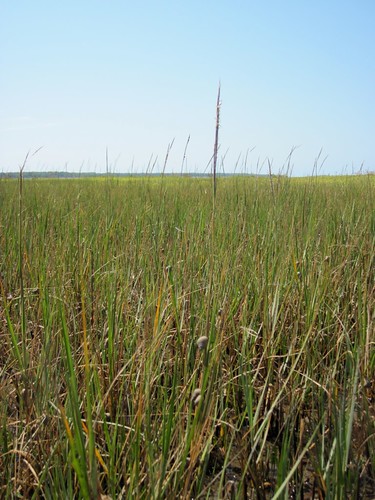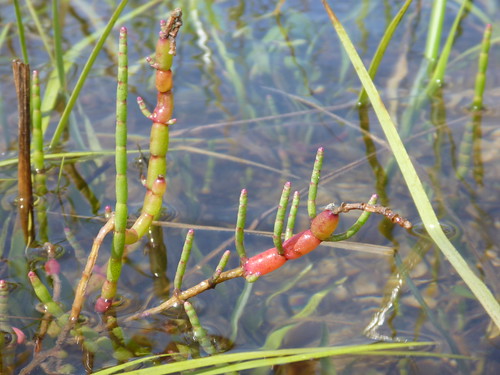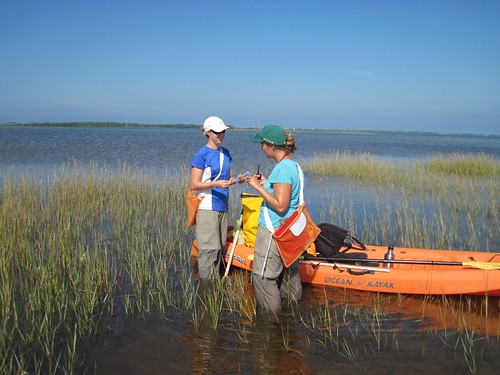Dr. Randall Hughes FSU Coastal & Marine Lab
 One doesn’t need to look at a calendar to realize that fall is upon us – recent cool mornings are a welcome sign. The marsh is also showing signs of change, with cordgrass flowering shoots springing up everywhere.
One doesn’t need to look at a calendar to realize that fall is upon us – recent cool mornings are a welcome sign. The marsh is also showing signs of change, with cordgrass flowering shoots springing up everywhere.
These stems are quite noticeable – they are taller than non-reproductive plants, and they have a “feathery” appearance due to the reproductive structures at the tops of the stems.
As I’ve mentioned before, cordgrass is one of those plants (like strawberries) that can spread by underground rhizomes, putting up new stems along the way. Alternatively, it can reproduce the “traditional” way, with reproductive stems that broadcast and receive pollen via the wind, ultimately producing seeds that fall to the sediment, get buried, and then germinate to produce new seedlings. Though conventional wisdom is that most new cordgrass stems are produced vegetatively by spreading rhizomes, it’s clear at our sites that these plants are investing a lot of energy in the other form of reproduction!
Cordgrass isn’t the only marsh plant that is flowering now – sea lavendar (Limonium carolinensis) is also in bloom, lending a very pretty purplish tint to the marsh (see video).
Though less obvious, succulent marsh plants such as Batis maritima and Salicornia virginica are also “flowering”.
So aside from creating new plant individuals that will potentially emerge next spring, what does all this plant reproduction mean for the marsh community? One interesting thing that we have noticed is that the periwinkle snails appear to congregate preferentially on the cordgrass reproductive stems.
It could be the reproductive plants are more nutritious / tasty to the snails, or it could simply be because they are taller and provide a better refuge from the incoming tide (and predators). Either way, snail grazing could reduce reproductive success. We’ll be collecting data and setting up some experiments in the next few weeks to try to tease apart what’s going on – stay tuned.
Another obvious sign of fall (at least for me) is the size of our lab group – with the start of university classes, several in our group have returned to school / other jobs and are no longer working with us at the lab. I have been slow to adjust my expectations of what we can accomplish to our reduced manpower, leading to several busy weeks recently! At least the (slightly) cooler weather makes for more pleasant long hours in the field.
Because the marsh doesn’t abide by the academic calendar, we’re continuing to go out to our sites regularly while the plants and animals are still active (typically until some time in November). Our surveys of the marsh community that started in April will give us an idea of seasonal changes among marsh plants and animals that we can use to devise future experiments and studies. We’re also trying to tie up loose ends from some of the projects we started this summer and run a couple of last minute experiments at the lab. At the same time, we’ll begin devoting more attention to processing samples that we collected this summer that have been sitting either in ethanol or in the freezer until we could get to them. And, of course, there’s lots of data to enter and analyze, so that I can spend the cold(ish) winter months holed up with my computer writing manuscripts…





2 comments
[…] I’ve mentioned before on the blog that we noticed lots of snails climbing on cordgrass reproductive stems this fall. In collaboration with David and his team, we visited marsh sites along the Panhandle to see if our observations would be supported with rigorously collected data. So far, so good! The trusty tank set-up at FSUCML. […]
[…] I made my first winter forays into coastal environments. Randall has already written about the seasonal shift from Summer to Autumn, where the flora and fauna are reproducing and animals are abundant in the marshes. Winter is an […]
Comments are closed.